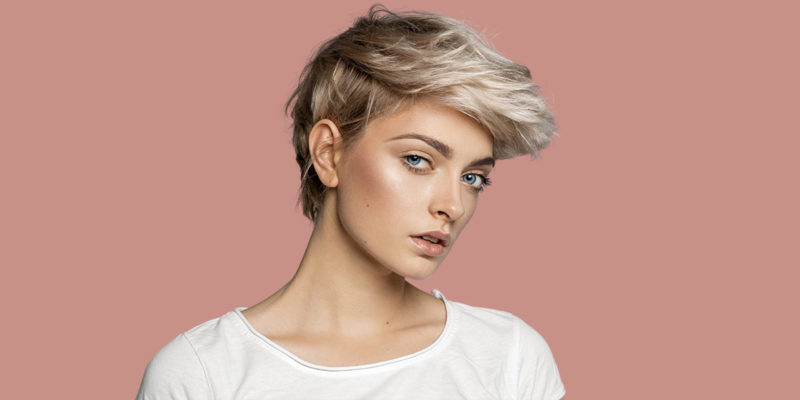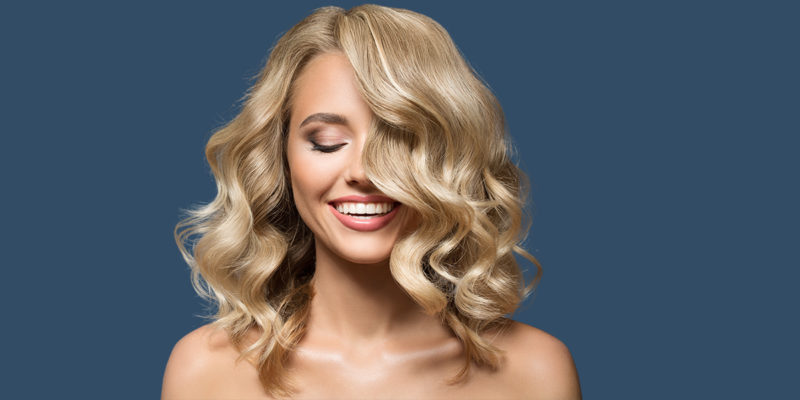Why Do Women Grow Facial Hair

Beards may look incredibly sexy on men, but when it comes to the ladies, a beard can be one of the many embarrassing and vexing problems a woman can face.
Most women like to keep their bodies completely hairless, while sporting a healthy and thick mane and a pair of wild or tamed eyebrows – it’s all in the taste.

Some women are gifted with super fine facial hair that doesn’t grow back for weeks, others have to face the issue of getting rid of their facial hair Every. Single. Day.
It can be very frustrating. The amount of hair and the thickness varies from person to person.
Peach fuzz, those spiky chin hairs and even coarse, dark hair growing all over your face can be removed using DIY treatments, at-home products, salon treatments and dermatologist treatments.
How Do You Know If Your Hair Is Healthy? Take The Hair Quiz and Find Out Now!
There are pros and cons of each treatment method of hair removal. You just need to decide which one suits you best depending on its price, the amount of time you can invest in hair removal, your facial hair type, how fast your hair grows back...
So how do you decide which treatment will work? We're going to cover:
- Why women grow facial hair
- Causes of facial hair in woman
- Facial hair treatment options
- Natural herbs & remedies
So, if you're a woman and you're wondering why you're growing hair on your face, pay attention. Here's what it means to you.
Causes of Facial Hair In Women
There are several reasons for facial hair growth in women. The most common cause is hirsutism, a disorder induced by androgenesis. Having this disorder means that you may have a genetic tendency toward facial hair growth which may not be “normal.”
Another common cause of excess hair growth on the face is polycystic ovary syndrome (PCOS).
More on these two later!
If you have excess hair on your face, make sure you see a doctor in order to rule out diseases that may contribute towards facial hair growth.
Some common examples include congenital adrenal hyperplasia, pituitary tumors, hormonal imbalance caused by elevated prolactin or androgen levels or liver disease.
Most of these conditions caused by hormonal imbalances can be treated with oral medication such as anti-androgens or birth control pills.
However, certain medications can even lead to excess hair growth on the face, such as anti-seizure meds, anabolic steroids, testosterone, Prednisone, and Tamoxifen.
Bonus: Download these 10 Aloe Vera Hair Gel Recipes for longer, stronger and healthier hair you'll fall in love with.
Furthermore, it is important to note that pregnancy and menopause can cause hormonal changes in the body, thus, increasing your likelihood of excess facial hair growth.
Let’s talk about what normal really is…
Most of us have too much hair on our face, or at least that’s what we think.
About 20 million American women remove their facial hair at least once a week. Sometimes, facial hair growth is normal but just looks too much for us. Excess hair growth can be a side effect of aging but when is facial growth normal?
Girls usually have fine facial hair on their face before puberty. This fine hair is called vellus.
However, following puberty, changes in hormone balance can lead to the growth of coarse dark hair called terminal hair on many parts of the body.
Terminal hair can be found under the arms (axillary) and pubic regions after puberty and is caused by androgens, or male hormones produced during this phase in a girl’s life.
Some women may notice terminal hair replacing vellus on the face.
If you have coarse hair growing on your face right now and compare your terminal hair with the vellus hair you had back when you were younger, you may begin to feel that your hair growth is abnormal and embarrassing.
In reality, this is completely normal, as explained above.
Changes like these can be upsetting but they are part of growing up and almost every woman experiences them as she ages.
Menopause can also lead to an increase in the androgen to estrogen level due to estrogen levels declining at this stage of a woman’s life, leading to excess hair growth on the face.
Moreover, if any one of the woman’s parents, or both, has thick and coarse facial changes, there is a possibility of her having it too.
It’s nothing abnormal and it can be controlled with simple and inexpensive hair removal methods. Thick facial hair is common in some ethnic groups and is thereby, normal in some families as well.
What’s Abnormal: Hirsutism
Hirsutism is a disorder induced by androgenesis which results in excess hair growth on the face. This can be accompanied by other changes in the body such as the cessation of menstruation, hair loss and balding and deepening of the voice.
It is important to note that hair loss is not typically the only symptom that can be caused by a true medical condition.
Symptoms of Hirsutism
Hirsutism is the growth of coarse, pigmented hair on a woman’s face, back and chest caused by exceedingly high androgen levels. Other signs and symptoms may appear with time – a process called virilization, which causes signs such as:
- Balding
- Deepening of the voice
- Acne
- Enlargement of the clitoris
- Breast size reduction
Hirsutism Causes
In most cases, the overproduction of androgens can lead to hirsutism. Androgens are produced naturally either in the ovary of the adrenal gland.
Ovaries produce testosterone, the predominant androgen and the adrenal glands produce DHEA, which is found in the market as a dietary supplement.
If you suspect that your androgen levels may be high, getting a simple blood test done will show you whether your DHEA or testosterone levels are high or normal.
Causes of hirsutism are summarized as follows:
PCOS
Polycystic ovary syndrome is the most common condition that is linked to excess androgen production and symptoms related to hirsutism such as hair growth on the chest, back and face.
Women with PCOS also typically experience irregular periods, multiple cysts on the ovaries, obesity and infertility.
Some women may develop diabetes as well. Fortunately PCOS can be treated with medication.
Dealing with PCOS and hate it more than anything? Read this inspiring story of a beautiful woman who dealt with her condition bravely after being bullied for years.
Congenital adrenal hyperplasia
Congenital adrenal hyperplasia is an inherited condition that causes the abnormal production of steroid hormones, such as androgen and cortisol. These hormones are produced by the adrenal glands which are situated right above your kidneys.
Adult onset congenital adrenal hyperplasia is a condition that is difficult to diagnose and is characterized by abnormally large adrenal glands. The condition is present from birth but symptoms will only begin to appear during adulthood.
Cushing’s syndrome
Cushing’s syndrome refers to a condition that occurs due to high levels of cortisol hormone in the body. This can take place due to two reasons: Either your adrenal glands are producing too much cortisol or you’ve been taking meds such as prednisone for a while now.
Tumor
Tumors of the ovaries or adrenal glands can lead to the production of excess androgens as well. Although such tumors are rare, they can lead to dramatically high androgen levels in the body leading to physical changes such as excessive hair growth and muscle enlargement.
Certain medications
Certain medications such as oral contraceptives that contain norgestrel can cause mild hair growth on the face as well. DHEA is an over the counter supplement which claims to build muscle and increase libido, but it can cause facial hair growth, as stated above.
Another drug called danazol can also be the culprit which is used to treat endometriosis in women.
Puberty
As a girl hits puberty, she begins to produce a mix of both female as well as male sex hormones. While this is completely normal, it can also be annoying for most women because it leads to pigmented, thick hair growth in the armpits, pubic area and face.
No identifiable cause
Sometimes we just don’t know the reason and your hair growth is hard to diagnose by doctors as well. In most cases, it’s difficult to identify the cause in certain populations such as of the South Asian, Middle Eastern and Mediterranean ancestry.
According to the U.S. Department of Health and Human Services, between 1 in 10 and 1 in 20 women of childbearing age suffers from PCOS. The condition currently affects up to 5 million women in the United States.
Complications
For most women, hirsutism can be an emotionally distressing and embarrassing issue. Women are often bullied for having facial hair and many feel self-conscious due to their unwanted hair.
Note that hirsutism does not cause any physical complications but the underlying cause of the hormonal imbalance may lead to irregular periods, PCOS, obesity, infertility and in some cases, diabetes.
Another critical note, if you’re taking certain medications to treat your hirsutism, talk to your doctor before deciding to have a baby.
Experts usually recommend avoiding pregnancy if you’re taking such meds due to the increased risk of birth defects.
A woman goes through hormonal changes all her life. These changes can cause changes in hair growth pattern and hair type.
It’s important to understand that women who have thick hair on their faces don’t have it because they don’t groom themselves or are “too lazy to wax.” They don’t enjoy having it and for some, removing the thick hair every day can be problematic. Some women have to shave their faces once or twice a day. Some have to hide their issue from their husbands or partners. Excess facial hair growth is a serious issue which can be caused by an underlying condition that can or cannot be controlled by the person suffering from it. Don’t bully a woman with facial hair. Period.
How To Diagnosing Hirsutism
A complete medical evaluation is required before any medical treatment for facial hair.
Along with a simple blood test to check your DHEA sulfate and testosterone levels, a detailed history is important too. Make sure you tell your healthcare provider about any vitamins or supplements you are taking.
If you’ve noticed any breast discharge, make sure you let your doctor know.
It would be best if you could take pictures of your changes in hair growth and show it to your doctor.
Physicians use something called a scorecard to visually determine whether hair growth is normal by checking the quantity of hair and hair type on the face.
If a simple blood test and medical history check does not rule out any causes of elevated androgen levels, you will undergo further testing to identify the cause.
Hirsutism Treatment Options
Women with PCOS may benefit from taking birth control pills to limit their facial hair growth. Birth control pills may cause the androgen circulating in the body to become inactive.
However, note that adrenal hyperplasia will require a different hormonal treatment as it cannot be treated with birth control medication.
Other medications such as spironolactone can inhibit the production of androgens. An anti-fungal drug called ketoconazole may block androgen production as well.
Make sure you see a doctor first before deciding a treatment method for your facial hair as treatment always depends on the cause, which in this case can only be ruled out by a doctor.
Hair Removal Methods
Whether you have too much or minimal facial hair, many hair removal options exist today which all come with their own set of pros and cons. The following are some options that you can try out to remove facial hair:
Threading
Threading is an ancient hair removing method most commonly used in Eastern countries such as India, Sri Lanka an Egypt. It’s becoming popular in the West as well and for all the good reasons; the best one being it lasts as long as a wax.
Furthermore, it is super sanitary. A cotton thread is used to pull along unwanted hair on the face in a twisting motion.
This ties individual hairs in a lasso and pulls them right out of the follicle. This means that your hair will grow back slowly. The thread is discarded once it has finished its duty.
It is important to understand that the rate at which hair grows back varies among individuals and while some may take up to 6 weeks to grow back their hair following a threading or waxing session, others may notice their hair growing back in just two days.
Threading works great for people who want to tame their wild eyebrows.
Threading is quick and precise when it comes to doing your eyebrows. Many people choose to get their eyebrows threaded instead of getting them waxed or tweezed because it shapes their eyebrows better and much faster.
The quicker the session, the lesser the pain.
Certain medications may conflict with sugaring, waxing or depilatories. People taking such medications may consider threading as an option.
There are some negative factors associated with threading as well. For example, if not done correctly, it may cause individual hairs to break half way and cause hair to grow back sooner.
Moreover, unless you live in an eastern country where threading is popular, you may not find a professional who can thread hair, especially your eyebrow hair.
Eyebrow threading is an art which requires time and practice, it’s not something as easy as waxing can be and cannot be learned in a few classes.
Threading pulls out hair from the follicles so it can be painful unless you’re used to it. Fortunately, it’s a quick process and if done from a person skilled at threading, you may not experience any pain at all.
Using a warm compress before threading may help relax hair follicles and reduce pain.
Threading is also a relatively cheap option but this of course, depends on the salon you visit.
Here's a video tutorial on how you can thread your face.
Waxing
Waxing involved removing the entire follicle from the root, just like threading and results can thus, last up to several days to several weeks, depending on how fast your growth normally is.
To wax the face, the wax is spread on a section of the face with hair on it in the direction of its growth.
A paper cloth is applied on the wax and is pulled off in the opposite direction of hair growth. This method is relatively quick because it pulls off several hairs in one go.
When you’re using hard wax, you don’t require a strip because it cools solid and you just have to pull it off the skin. When done correctly, the wax should pull hair from its hair follicles.
Waxing can be done at home or at a salon. You can get waxing kits and waxing supplies and cold wax strips at any local beauty supply store.
One major con is that waxing can be super painful for some people. However, for others, waxing can be almost painless, especially if done by a professional. In order to wax, you need to have at least a quarter inch of hair on your face for the wax to adhere too.
Waxing at home can be messy.
Additionally, if you’re visiting a salon, make sure it follows sanitary procedures to prevent skin infection. Sometimes waxing may lead to irritation and bleeding if done twice on the same area.
Therefore, once you wax off, instead of waxing on again, just tweeze, thread or shave the remaining hair.
Depilatories
Depilatories for the face can be found in cream, lotion and gel form. The chemicals in them dissolve the hair that’s above the skin’s surface.
Depilatory creams work by dissolving the hair at the skin's surface
Depilatories are fast, cheap and cause no pain at all. It’s almost like shaving, except you don’t use a razor.
However, since you’re using a product with chemicals, it may cause irritation to the skin.
Depilatories also have an unpleasant odor which most people cannot stand. Make sure your purchase a depilatory that is made for the face only. Body depilatories can be too harsh for the sensitive skin of your face and may cause irritation.
People with super sensitive skin should avoid depilatories as they may cause rashes, blisters or burns. Avoid applying the product to sensitive regions of the face such as around your eyes.
Do a patch test 3 days before trying the product of your choice by applying it inside your arm.
Pro tip: Always apply SPF 30 sunscreen before going outside if you remove your hair with depilatories.
Shaving
A razor or an electric shaver can cut your hair close to the skin. Make sure you use shaving cream, soap or coconut oil if you’re using disposable razors.
Always shave in the direction your hair grows and replace your razors frequently. Using dull razors can lead to cuts and bumps. Razors can be used anywhere, even on the face. In fact, shaving removes the outer layer of dead skin cells, giving you a nice exfoliation.
It’s a common myth that shaving leads to thick hair growth. Since shaving cuts your hair off the soft tip, the hair that grows feels coarser.
Shaving, of course, doesn’t keep you smooth for days. For many, hair grows back within 1 to 3 days. It can be exhausting to shave frequently, so it’s not the best facial hair removal approach for many women but it’s a great go-to approach especially if you’re in a hurry.
Electrolysis
Electrolysis is a permanent hair removal method. A trained technician will place a tiny needle inside each hair follicle on your face, destrouing its root with an electric current.
Since this technique works on individual hairs and takes a lot of time, it’s best for small areas or removing a few hairs such as the spikes under your chin.
You’ll have to get treated ever one to two weeks until your hair is gone.
Side effects may include scarring, swelling and redness. Do your research and find a skilled specialist in your city. Electrolysis is an expensive treatment method and since it requires multiple sessions, the cost can add up. However, it is permanent and is worth the investment for many who can afford it.
Laser
A skilled technician destroys the roots of your hair with strong light beams. Laser of intense pulsated light (IPL) is a permanent hair removal solution that can be done anywhere on the body, including the face. IPL works best for women with pigmented hair and light skin.
You’ll require 6 to 12 treatments before you see results. Touch up appointments may be needed every 6 to 12 months as well.
Laser hair removal can lead to swelling and redness.
There is a chance of burning and scarring so make sure you go to a place where there is a doctor as part of the staff to treat any complications resulting from the treatment.
Home remedies and supplements
If you want to try something inexpensive and risk-free, there are many home remedies that treat facial hair but they don’t guarantee results.
Moreover, they’ll most likely work on women who don’t have thick, dark hair on their faces but they’re definitely worth a shot because they are natural and may not cause side effects:
Spearmint tea
Drinking spearmint tea every day has been known to reduce testosterone levels in the body, thus, leading to a decline in hair growth as well. Experts recommend drinking 2 cups per day to see results.
Vitamin B6
Taking vitamin B6 prevents the excess production of testosterone in the body and can help in reducing hair growth on the face. A diet rich in vitamin B6 may help so focus on consuming bananas, potatoes, fish, hazelnuts, dairy and collard greens to reduce facial hair growth.
Soy products
Soy consists of phytoestrogen, which is equivalent to estrogen, just in plant form. This may discourage facial hair growth so try to have more soy products in your diet such as tofu, TVP, tempeh, soy cheese and soy milk.
Turmeric
Turmeric has many amazing health benefits as we've talked about here and here. Applying a turmeric paste with turmeric and water and leaving it on for 15 minutes may reduce hair growth. You can mix it with gram flour and use it as a scrub too.
A turmeric-yogurt mask can not only reduce hair growth but even your skin tone as well.
Turmeric is an ancient remedy used to increase skin glow and remove facial hair. Although, there is a high likelihood that it may not work for most women, it can be used to prepare an organic face mask that does wonders to your skin!






